At around 9:00 at night, the temperature in Magelang finally drops to a more hospitable 28°C from the 37° or so that it’s been hovering at. My girlfriend and I are here, just outside Yogyakarta, for this leg of the trip and we’ve stopped at a warung for dinner — think of a small trailer that can be pulled behind a bicycle serving ridiculously tasty food. This warung is known for several noodle dishes, but we’ve asked for mie godog — literally, “boiled noodles”. The broth from this cart is made with candlenut and it’s cooking overtop some hot coals in a wok with spring onions, garlic, some mustard greens, and the aforementioned egg noodles. Every few seconds, someone on a scooter or motorbike putters past, inches from the trio of younger men sitting and smoking on the stoop of the karaoke bar next door.
I’ve taken a couple of Live Photos of the scene and play them back, and I realize that it’s captured the sights and sounds well enough that I’ll be able to show my friends and parents back in Canada, but something’s missing: the smell of this place. It’s a distinct blend of engine fumes, clove cigarette smoke, burning wood, and this incredible food. This, to me, says worlds about the immediacy of place of Live Photos, as well as the limitations that they have. They are a welcome step closer to better capturing a moment in time, but the technology isn’t quite good enough yet for this moment.
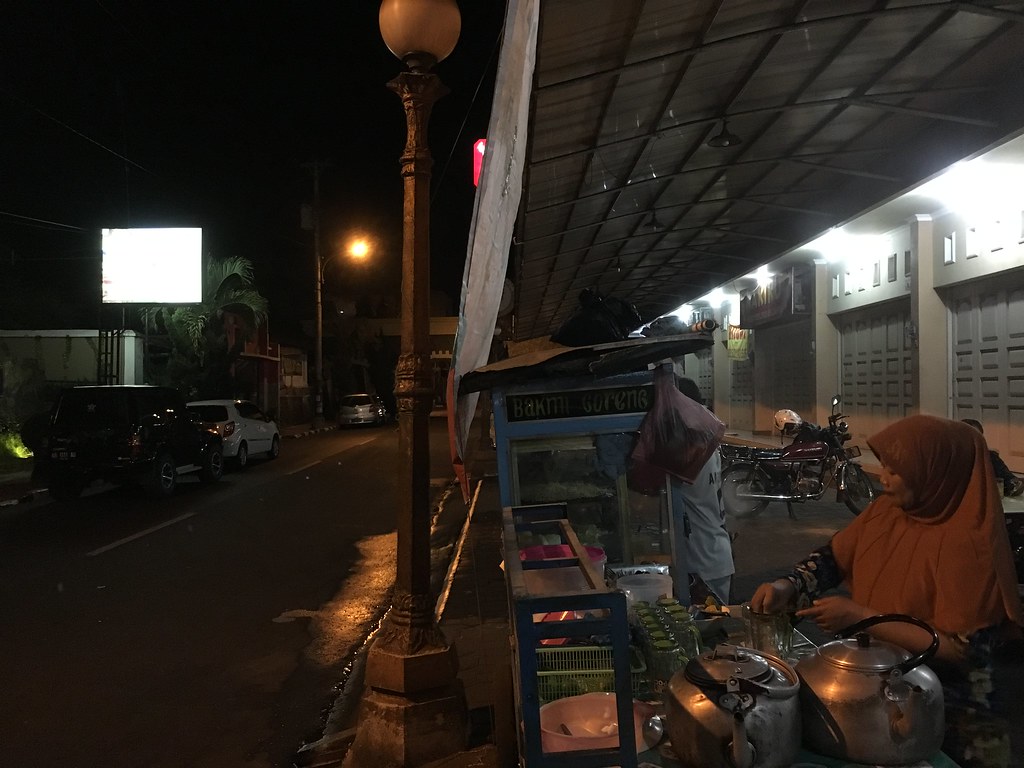
I’ve been using an iPhone 6S since launch day — “Space Grey”, 128 GB, non-Plus — and I’ve read all the reviews that matter. But when I boarded a plane on October 24 from Calgary to Surabaya, I was unprepared for the way that this product would impact my travels, and how my travelling would impact my understanding of mobile technology.
We begin this story during a stopover at Vancouver International Airport. As this is an upgrade from an iPhone 5S, I’m still getting used to the size of the 4.7-inch 6S. After just the short hop from Calgary, I’ve noticed that my 6S feels less comfortable in my front-right jeans pocket, to the point where it becomes an obligation to remove it upon sitting down in a tight airplane seat.
This issue is exacerbated by the addition of a case. I never use one, but I felt that it would make my shiny new phone last a little longer in the rougher conditions I’d be experiencing at some points of my trip. My Peel case didn’t show up in time — something about a fulfillment issue — so I settled for Apple’s mid-brown leather model. It’s nice, but even after just a couple of days, I’m already seeing staining on the edge of the case, where it wraps around the display.
At least it gets rid of that damn camera bump.
My girlfriend and I kill some time by hopping on the moving walkways and checking out some of the kitschy tourist shops that dot the halls. I pull out my phone and take a few short videos across the different available video quality settings. I’m sure 4K looks better, but I don’t have a display that can take advantage of that resolution; 60fps looks great, but also looks too much like a home movie. I kind of wish Apple would add a 24fps mode, for a more cinematic feel. I settle on 30fps 1080p: it’s not exotic or technologically advanced these days, but it works pretty much everywhere and looks gorgeous. Even without the optical stability of the 6S Plus, I’m still impressed by how well the camera cancels out shakiness.
After a couple of hours, we board the twelve-plus-hour flight to Taipei. I pull my phone out, sit down, and notice that the Airbus seats lack power outlets. I check my phone, and it looks like there’s 50-odd percent left. In airplane mode, it should be fine for listening to music for much of the flight and taking the odd photo and video. Maybe without much battery life to spare, I’d even get some sleep.
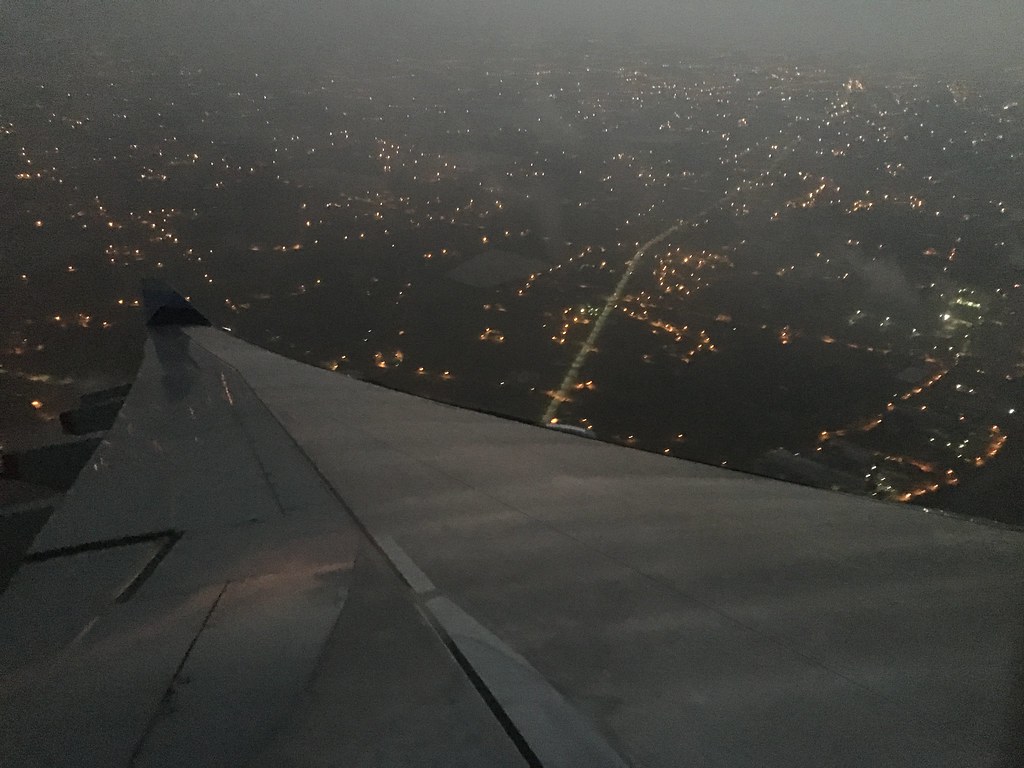
We land in Taipei bright and early, and steer immediately to the complimentary showers to freshen up. My iPhone is on the last drips of power in low battery mode, but the shower room has an outlet to top it up. We have an eight-hour layover here which we’ll be spending entirely in the airport — thankfully, with free and reasonably speedy WiFi.
I review the photos I’ve taken while circling the city earlier and am pleasantly surprised at their quality in the dim twilight and smog.
In a little over two hours, we’ve seen most of the airport, which, as with every other, consists of duty free shops only occasionally separated by small cafés and restaurants. There are plenty of tech-related shops selling iPhones, MacBooks, and iPads, all at prices much greater than the exchange rate would suggest. Even outside of the airport, Apple products, in particular, are expensive on this side of the world, especially for the middle-or-lower-class income bracket.
I try to log into Tumblr, an account on which I’ve enabled two-factor authentication via text message. I realize that I cannot receive the confirmation message as I’ve turned off all data on my phone to avoid exorbitant roaming charges. Damn.
After another few hours spent walking throughout the airport in a fruitless search for a basic and inexpensive shirt, it’s finally time to board the flight to Surabaya via Singapore.
Despite taking the same plane and the same seats for the second half of this flight, it’s necessary — for some reason — to leave the aircraft and turn around, passing through a security check again. This irritates me, as my pockets and bag are full of crap that I’ve accumulated in entirely “secure” zones, yet cannot be brought back onto the flight.
To make matters worse, the WiFi at Singapore’s airport requires text message authentication, which I cannot get, cf. my troubles logging into Tumblr. It’s also usually possible to get a code from an attendant, but none are present because it’s late at night, of course.
Thanks to the extra memory in the A9 SoC, I still have plenty of Safari tabs cached so I don’t necessarily need a live internet connection. Unfortunately, it hasn’t preserved all of them — the camera still takes as much memory as it can. My pet theory is that Apple could put desktop levels of RAM in the iPhone and the camera would still purge Safari tabs from the cache.
It’s 11-something at night by the time we land in Surabaya. My phone retains a decent charge despite none of the planes including seat-back power outlets. We exit the airport into the overwhelming Indonesian humidity and heat, and hop into a small van to take us to our hotel.
As we wind through the city, I try recording with my phone pressed against the window. If you’ve ever filmed anything at night in even a moderately well-lit city, you know how difficult this is; in Surabaya, with its extremely dim lighting, almost nothing is visible. I put my phone on the seat and watch the city scroll by.
In the morning, we head over to the mall to pick up a SIM card for my time here. On Telekomsel, 4 GB of 3G data plus plenty of messages and call time costs me just 250,000 Rupiah, or about $25 Canadian. I later learn that it should have cost about half that, but I’m a tourist. Whatever the case, that’s a remarkable deal; at home, I pay $55 per month for 1 GB of data.
I’ve never previously tried swapping my SIM while iMessage is active, or adding a phone number to an existing iMessage account. I have to power-cycle my phone so that Telekomsel can activate the SIM, and another time to get it to work with iMessage, after re-enabling cellular data.
But it doesn’t quite work correctly. I’m presented with a prompt to “update” my Apple ID password, and I can’t figure out whether I need to set a new password or simply type it in again. I try the latter and find that the WiFi hotspot I’m connected to is too slow to reach the Apple ID servers. I try a few times, try a third power cycle, pop in my Apple ID password again, and iMessage is finally activated.
I try messaging a friend in Calgary. To my surprise, it fails. I realize that I must add the country code; despite having prior correspondence of several years while in Canada, it does not automatically resolve this. My friend reports that he’s receiving messages from both my new Indonesian number and my iCloud email address. I chalk this up as another instance where iMessage doesn’t understand that we typically want to message people, not numbers or addresses.
I get a tap on the wrist: my Apple Watch notifies me that it is using iMessage with the same email addresses that I’ve been using for years. Sigh.
After two days in Surabaya, we board a plane for Bali. Destination: Ubud, near the middle of the island. After checking into our hotel, I grab my “proper” camera and head off on a short walking tour of the area.
I’ve opted to bring my seven year-old Canon XSi — coincidentally sporting the same 12 megapixel count of the iPhone 6S — and Canon’s cheap and cheerful 40mm portrait lens plus a polarizer on this vacation (those are affiliate links). It’s not the latest gear, but it’s versatile enough when accompanied by my phone.
Ubud is a fascinating little town. It isn’t coastal, so we don’t get any beach time, but it’s an artistic and vibrant place. It happens to be extremely hot during the early afternoon, which makes spending any extended time under the sun uncomfortable and delays the time that we decide to explore. Due to Bali’s proximity to the Equator, the sun sets somewhere between 5:30 and 6:00, and “magic hour” seems to last the entirety of late afternoon. That’s great news for my vacation photos.
In spite of the heat, we take a walk one afternoon in search of some sandals; the ones provided by the hotel are fine for the room, but not for walking around the city. We duck into a small restaurant for lunch, and my girlfriend orders sate. It’s served in a miniature clay grill overtop hot coals, and I realize that this is the kind of moment the Live Photo feature was built for.
Other reviews have pointed out that it’s sometimes hard to remember that the video component continues to record after taking the still photo. I find it difficult to remember that it begins to record video before tapping the shutter button, so I must remember to wait a couple of seconds between tapping to focus and snapping the still; I must also remember to keep my phone raised after taking the picture. It takes me a few tries to get the hang of it, but I’m pleased by the result. Yet, I cannot share it with anyone — a month after the 6S’ release, it seems that none of the popular services that I use support Live Photos.
The next night, we explore the city later in the afternoon, when it’s a tiny bit cooler. I haven’t remembered to bring my DSLR, as we only plan on going for dinner and poking around some boutiques.
We spot a sign directing passers-by to a rice field “50 metres” away, and decide to take a look. After a walk of probably double that distance along a very sketchy path, with sheer drops on one side, we arrive at one of the most breathtaking landscapes I’ve ever seen. Rice paddy fields stretch from both sides of the single-track lane, framed by coconut trees. A rooster crows in the distance. The sun is low in the sky behind a bit of smog, so it’s a perfect golden hue.
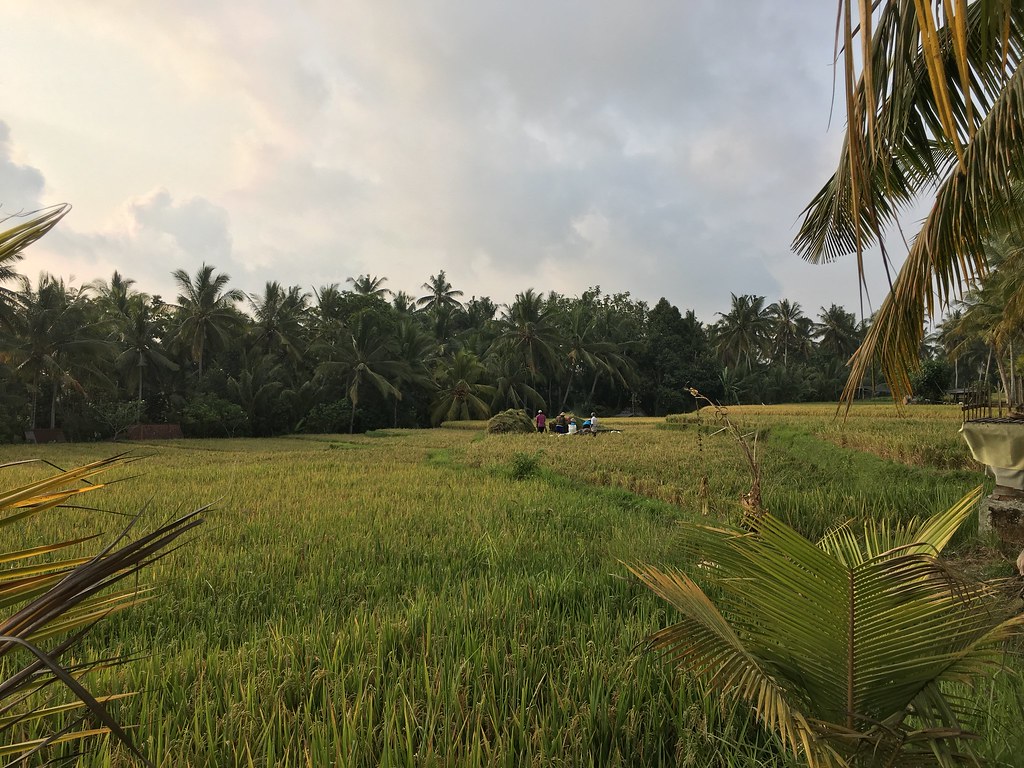
It’s so beautiful that it takes me a few minutes to remember to pull out my phone and, low-ish battery be damned, begin snapping. I snap plenty of landscapes on either side, take the requisite panorama, and even a few Live Photos. Later at the hotel, I review these photos and realize that I can’t remember which ones are “Live”, and which ones are not. I look in vain for a Live Photos album; despite every other “special” photo and video format available on the iPhone being filtered into their own album, it simply doesn’t exist for Live Photos. I try searching “live”, or looking for an icon in the thumbnail view — neither works.
I finally stumble across them as I swipe through the photos I shot on the rice fields that day and notice a slight amount of motion. This is apparently the only indicator of a Live Photo, and the only way to find one. Not easy.
But, as I take a look at the few I’ve shot so far, I see great value in the feature. Live Photos can’t capture everything, but they greatly enhance an otherwise static scene. The sound and video snippet add context and a better sense of place: the rooster crowing, the crickets, and even the steam and smoke curling up from that sate the previous day. I have some perfectly fine still photos, too, but their context is entirely imagined; every Live Photo I’ve taken so far does a better job bringing the memory back. It’s too bad that the heat and smell of the place can’t yet be captured as well.
In any case, I don’t think Live Photos are the gimmick some see them as. They’re a little bit cute, but they work remarkably well.
We spend a day travelling from Ubud to Seminyak and seeing the sights there. Our driver, Sandi, had in his car — among the television screens, faux fur on the dash, and short shag roof liner — a USB outlet for passengers to charge their phones. But, he tells me as I plug mine in, most people just use their power banks. I tell him that I’ve noticed a lot of portable batteries around and he says that some people carry two or more, just in case. He says that this is completely normal.
I’m starting to question the power consumption of my own phone. I’ve used it for long enough in Calgary that I know that I can get a full day’s use out of it, from 7:00 in the morning until late at night. Here, I’m not getting even half that. I check the battery statistics and see that all of my usual web-connected apps have a “low signal” notice.
Not only is 3G service somewhat slower than you might expect in this region, it also has patchier coverage. That eats battery life at a much more significant rate, particularly if you have background services polling for data regularly. iOS is supposed to compensate for this, but if you have email inboxes set to refresh on a timed schedule, it seems as though it will obey that regardless of signal strength.
The low battery mode in iOS 9 does a good job of substantially increasing battery life when cellular coverage is less than ideal. I find it indispensable: coverage is too poor for my inboxes or Tweetbot to refresh regularly, and I don’t really want to check my email much while on holiday anyway.
After dropping our bags at the hotel, we head to Uluwatu for the world-famous kecak dance, performed at sunset on a cliff above the sea. I am so captivated by the dance that I all but forget to take photos until the climax, where the dancer playing the monkey is encircled by fire.
We hang around following the dance to take photos with some of the performers. There are a couple of floodlights illuminating the stage area, but it’s still pretty dark. We get our turn to take a selfie with the monkey performer, and I turn on the new front-facing flash. The photo comes out well — great white balance, well-exposed, and not too grainy — but we look sweaty and tired; I shall spare you that sight.
The next day, we head to the beach. Our hotel is just two blocks away, but even that feels sweltering; the cool waters of the Indian Ocean are beckoning. I shoot with both my iPhone and DSLR here. Normally, I’d be very cautious about stepping into the waves for some more immersive shots with my iPhone pocketed, but the increased water resistance of the 6S gives me more confidence that a few light splashes won’t be an issue, especially with a case.
When we get back to the chairs by the side of the beach, I notice that some lint from my pocket has accumulated around the edges of the case. I pop my phone out to dust it off and notice just how nice it feels in the hand. It is not, to my eyes, the best-looking iPhone industrial design — that would be the 5S followed by the original model — but it is the best-built, by far, and feels fantastic in the hand, despite the size. I’m looking forward to using it regularly without a case again at home.
We weave through Seminyak, then onto Yogyakarta, Magelang, and Rembang. Dinner in the latter two cities is often spent at warungs — it is some of the best food you can have anywhere, provided you know which ones are clean.
Our last dinner in Rembang is in a particularly interesting warung. The proprietor is known for his interpretation of nasi tahu — literally translated as rice and tofu. He sets up his preparation table surrounded on three sides by small, low benches, each of which can seat no more than three or four people. Tarps are draped overtop to protect against the possibility of rain — ’tis the season, after all.
We’ve squeezed ourselves onto the bench directly opposite the cook, currently mashing together peanuts, garlic, lime, and some broth into a paste while frying fist-sized lumps of tofu. It’s crowded and, with a bubbling wok of oil behind the cook, it’s hot, but the combination of every sensation makes the scene unforgettable. I want to show people at home, so I take a few photos on my iPhone of the cook at work, trying also to capture the close quarters of the space.
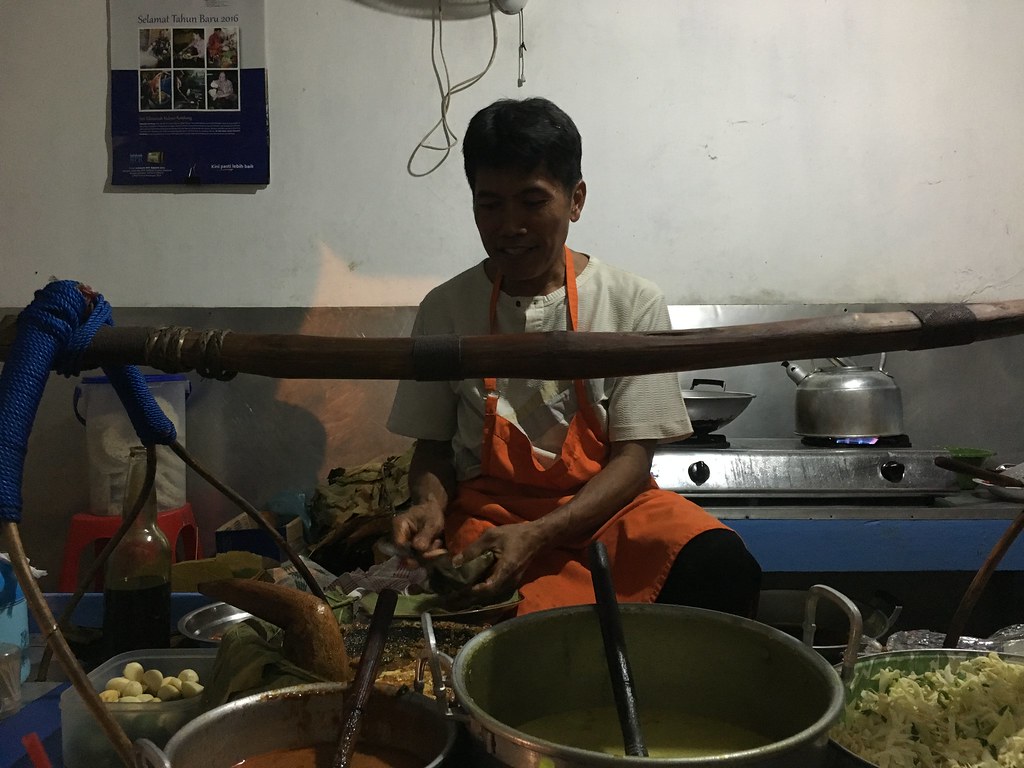
It occurs to me that taking photographs in this environment would be unnatural and straining were it not for a camera as compact and unassuming as my iPhone. Even my DSLR equipped with a pancake-style portrait lens — which I’ve specifically chosen to be less imposing — would be too obtrusive in this moment.
The final few days of our vacation is spent at a home in Surabaya that doesn’t have WiFi. That’s fine in terms of my data consumption, but the slower 3G connection tends to choke on any modern media-heavy site. Every unnecessary tracking script and every bloated cover image brings my web browsing to a crawl.
Then, I run into an issue where my connection refuses to complete. My iPhone shows me a dialog box informing me that there has been a “PDP authentication failure”. I do not know what PDP is, why it must authenticate, or why its failure means I can’t load anything online. I reset my network settings and that seems to work for a while, only for PDP to be unauthenticated again, or whatever.
I reset and search the great IT help desk that is Google for an answer. The top result is a Reddit thread, so I tap on it, only for it to fail to load. I page back and try an Apple Support thread link and it works fine; though, of course, it has no answers. Reddit, specifically, will not load on my 3G connection.
I get sidetracked from my PDP issue and do a little bit of digging. It turns out that Indonesian pornography laws prohibit both porn itself, and any conduit for it. Though Indonesia does not have a nationwide firewall a la China, the federal government has pressured the major ISPs and cellular networks to block major sites that allow access to porn.
Later in the day, we get carried away at Historica Coffee and forget to grab dinner. There’s not much open at midnight on a Wednesday, particularly if you’re not that interested in maybe-it’s-food from sketchier vendors.
I swipe to the right on my home screen expecting to see shortcuts to late night food, but that feature isn’t enabled here.
I open Yelp. “Yelp is not available in your country.”
We opt for a nearby late night Chinese food place, and it’s pretty damn good.
On the long series of flights home, I get a chance to review photos from both my DSLR and iPhone while triaging my Instapaper queue. I have more than a few articles saved that proclaim that the camera in an iPhone today is good enough to be considered a camera, not just a smartphone camera. These articles began to percolate around the time of the iPhone 4S, and they are a perennial curiousity for me, especially as I glance at my screen of crisp photos taken on my DSLR.
There’s no question that an iPhone has never had a better camera than those in the 6S and 6S Plus today, with the latter edging out the former due to its optical stabilization. iPhones — and smartphones in general — have taken very good quality photos for the past few years, and I would not hesitate to print or frame any of them. In fact, every photo in this travelogue is unedited, and I think they all look pretty good.
But I’m looking now at photos from that paddy field back in Ubud, and there is an inescapable muddiness to the trees in the background. I didn’t bring my DSLR on that walk to compare, but I’ve no doubt it would render a vastly clearer and more detailed image.
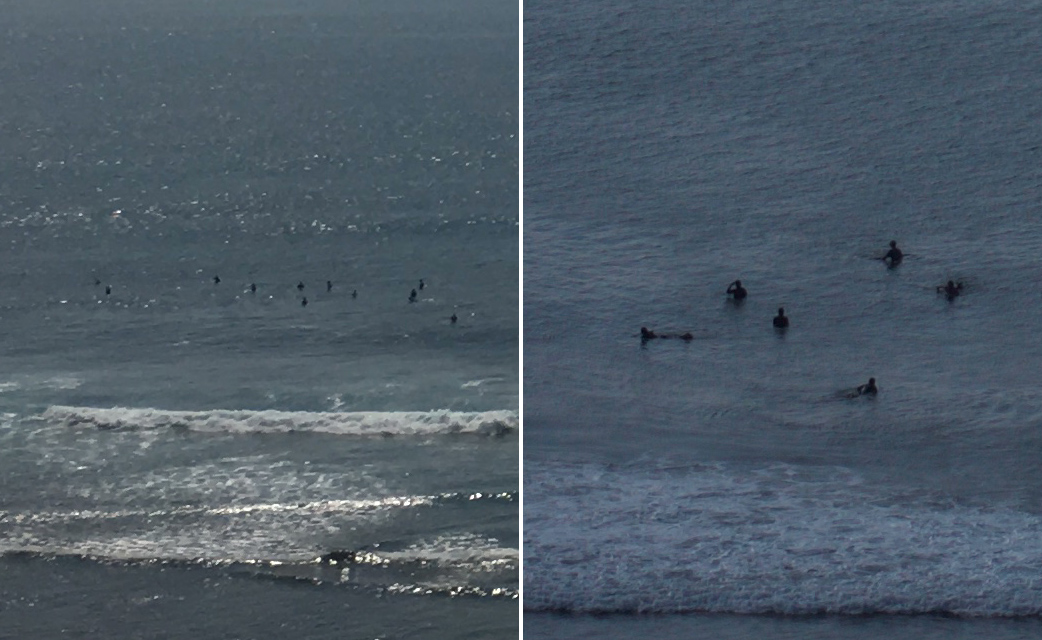
Similarly, I have photos taken on both cameras from atop a cliff near Uluwatu of surfers paddling in the waves. The wide-angle lens of my iPhone provides a better idea of the scope of the scene, but the surfers are reduce to dark blobs. The images captured on my “real” camera show the clarity in the water and the surfers are clearly human beings.
This is, of course, a completely unfair comparison: the APS-C sensor in my XSi has about ten times more area than the iPhone’s sensor, and it’s paired with a much bigger lens which allows more light in. But, it does illustrate just how different the quality of image is from each device.
There are all kinds of tricks that are easier with a DSLR, too, like tracking focus from or of a moving object. For example, I will look through the windshield from a moving car for potentially interesting roadside scenes. Upon spotting one, I’ll grab focus of something of a similar focal distance as the objects of the scene, then move my camera in the opposite direction of travel at a similar speed. This is much easier on highways where speeds are constant, so I’m able to develop a rhythm of sorts. With my DSLR, this is tricky, but something I can reliably do; I have never succeeded in using this technique on my iPhone. It might be the rolling shutter or something I’m not doing quite right, but I also have not heard of someone else doing something similar.
I offer this not as a complaint with the iPhone’s camera, but as clarification that there is still great value to having a camera with a big-ass sensor and a great lens. I’m under no illusions; I am an optimistic hobbyist photographer, at best, but I can’t shake the feeling that I made the right decision in bringing my DSLR as well. It’s bulky, cumbersome, old, has “hot” pixels on the sensor, and creates gigantic RAW files that occupy a lot of space on my MacBook Air.1 However, it creates beautiful images to last a lifetime, and that’s what counts most for me.
I’ve spent an hour or so in an “e-library” in Taipei’s international airport wrapping up this travelogue. Nobody seems to use the e-libraries here, so they function as a pseudo-private lounge, and a pretty great place to find a power outlet. It’s quite nice.
There were some things I expected about bringing my iPhone to Indonesia. I anticipated that I’d use it to keep in touch with a few people at home, look up addresses and directions, and be able to take great-quality photos anywhere, any time. But I learned a lot about the phone, too: Live Photos showed their brilliance, and I was able to extend my battery life despite none of the aircraft including seatback power. I found out just how well the camera works for capturing intimate moments that would feel artificial or posed if I were to use my DSLR, and figured out some new iMessage limitations.
What I learned most, though, isn’t about the iPhone 6S directly; it’s about the role of technology and the internet in a developing nation.
In most developing nations, the proliferation of technology is limited by policy and economics; Indonesia is no exception to this. But, while I was there, I saw people regularly carry two, three, or more smartphones: usually an inexpensive Android phone — something like a OnePlus or a Xiaomi — plus either an iPhone or a BlackBerry. Apple’s products are still very much a luxury: an iPhone is about a third more expensive in Indonesia than it is in the United States, while the median income is half that of the U.S.2
The Jakarta Post reports that only about 29% of Indonesians are connected to the internet, and the internet they’re connected to is different than the one you and I are used to. But they’re making the most of what they’ve got, and established their own rules and understanding — it isn’t rude to use your phone at the dinner table, for instance, and Path remains alive (remember Path?). Not all the services and products you and I have come to expect have made their way there, and if you think search in Apple Maps is poor where you live, you’ve seen nothing yet.
I escaped to Indonesia for a relaxing vacation in a part of the world I’ve never visited. I vowed to get off the beaten path and out of my cushy boutique hotel. In doing so, I leave with a hint — but only a hint — of what life is like for hundreds of millions of Indonesians. In doing so, I learned a little bit of how they use technology; their smartphone is often their only computer and only connection to the internet.
There is something further to consider here: we — designers, developers, and product people — spend a lot of time worrying about how our new product looks and works in U.S. English on an LTE connection, for the tastes of an American (or, at least, Euro-centric) audience. We spend little time asking how it will function for people who fall outside those parameters — parameters which, by the way, narrow as fast as greater amounts of people get connected to the web. My quip about Path earlier is indicative of this: we assume Path is dead because we don’t use it; yet, it has, as far as I can work out, a respectable user base in Southeast Asia, and that market grows every day.
I’m not pretending to be fully educated in the country after spending just three weeks there, but I am certain I understand it better than three weeks ago. Indonesia is beautiful, breathtaking, delicious, and full of the nicest and most accommodating people I’ve ever met, and I’m Canadian. You should go. Bring a camera.
-
Not to mention post-processing in Photos on OS X, which remains an app that is hard to love. My workflow for a trip like this is to shoot hundreds of images, import them all into one album for the trip, and then pick my selects from that album.
In Aperture, I’d give five-star ratings to the images I was certain about, four-star ratings to those that might have potential, and no stars to images I wouldn’t bother using. (The digital packrat in me doesn’t delete them — just in case, I suppose.) Then, I could simply filter to four-star-or-better images and edit within that set, upgrading some to five-stars if I deemed them worthy. Exporting was as simple as selecting the already-filtered set within the album.
Photos doesn’t have this level of granularity: you either “like” a photo, or you do not. That keeps things a lot simpler, and I don’t mind that. What I do mind is that there appears to be no way to find only photos I’ve liked within an album. My workaround has been to create a smart album with that filtering criteria, but that seems like a workaround, not a solution. ↥︎
-
This has other effects, too: a couple of years ago, I guessed that data problems and inconsistencies in Apple Maps would be less frequent in places with more iPhone users, and I think that’s true. With less penetration in Indonesia, Apple Maps often lacked significant local points-of-interest. ↥︎